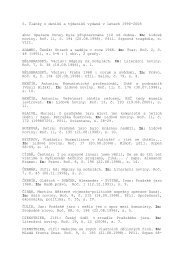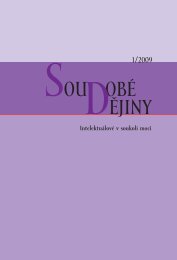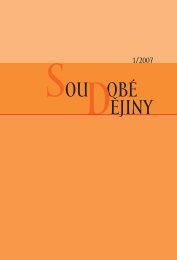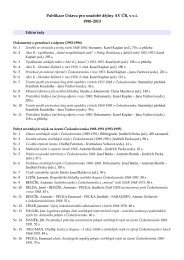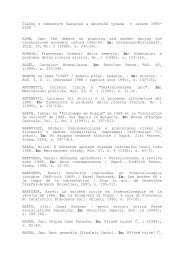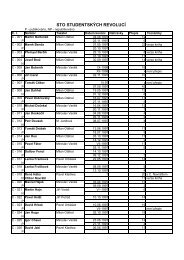- Page 1:
Rozděleniminulostí1Vytvářenípo
- Page 6 and 7:
6© Adéla Gjuričová, Michal Kope
- Page 8 and 9:
8Nedominantní strany.Osudy „mal
- Page 10 and 11:
10pluralitní parlamentní demokrac
- Page 12 and 13:
12komparativní perspektivu, vychá
- Page 14 and 15:
14historiografie. Ta usiluje o to,
- Page 16 and 17:
16skutečnosti, a tedy i v politick
- Page 18 and 19:
1818
- Page 20 and 21:
20že máme-li se dohodnout na spol
- Page 22 and 23:
22„Nejsme jako oni!“Nejeden pol
- Page 24 and 25:
24tvrdého potlačení manifestace
- Page 26 and 27:
26přerušenou činnost ustavením
- Page 28 and 29:
28a na protest opustili schůzi Fed
- Page 30 and 31:
30policejní a justiční zvůle, a
- Page 32 and 33:
32jenže „v hospodářské sféř
- Page 34 and 35:
34kritérii odvolávání vedoucíc
- Page 36 and 37:
36Vystoupení předsedy české vl
- Page 38 and 39:
38„Druhá revoluce“ a „odsouz
- Page 40 and 41:
40starých managementů. Jan Štern
- Page 42 and 43:
42přesto se toho moc neděje, [k d
- Page 44 and 45:
44Rozklad Občanského fóra fóra
- Page 46 and 47:
46fóra Václava Klause - se odehr
- Page 48 and 49:
48Již 27. února 1991 zveřejnila
- Page 50 and 51:
50spolupráci s československou St
- Page 52 and 53:
52je nezbytné důkladně ve Feder
- Page 54 and 55:
54(např. z antikomunistické persp
- Page 56 and 57:
56zatížení“ komunisté by měl
- Page 58 and 59:
58režimem se hlásily o slovo. Ož
- Page 60 and 61:
60prostředky. Proto je také přir
- Page 62 and 63:
6262
- Page 64 and 65:
64nevyhraněného - hnutí. Mělo n
- Page 66 and 67:
66dějinného zla, a praktickou rov
- Page 68 and 69:
68a považovali je za předčasné.
- Page 70 and 71:
70Postkomunistické liberalismyve s
- Page 72 and 73:
72První z nich bývá nazýván et
- Page 74 and 75:
74nejsilnější vládní zastoupen
- Page 76 and 77:
76Jestliže byly Pithartovy konzerv
- Page 78 and 79:
78Ovšem všechny tyto politické m
- Page 80 and 81:
80mít šanci uspět, musí se jedn
- Page 82 and 83:
82obhajuje zásady odborně nesporn
- Page 84 and 85:
84liberalismem. 39 Manažer volebn
- Page 86 and 87:
86nejen v řadách poslanců a vlá
- Page 88 and 89:
88zpochybňoval jeho praktický dop
- Page 90 and 91:
90této aféry další posílení o
- Page 92 and 93:
92založený na iluzi, že existuje
- Page 94 and 95:
94liberalismu v domnění, že po p
- Page 96 and 97:
96Avšak programové vymezování o
- Page 98 and 99:
98jménu obrany národních zájmů
- Page 100 and 101:
100kulturu, členské složení, po
- Page 102 and 103:
102předmětem žádné diskuze. N
- Page 104 and 105:
104a znamenal také definitivní ro
- Page 106 and 107:
106transformace jako otázku ústav
- Page 108 and 109:
108108
- Page 110 and 111:
110Tradici navzdory, navzdory. Ale
- Page 112 and 113:
112zřejmě v říjnu přemluvili K
- Page 114 and 115:
114ovlivněná. Od sklonku podzimu
- Page 116 and 117:
116K tomu se od samých počátků
- Page 118 and 119:
118že občané negativně vnímaj
- Page 120 and 121:
120své kořeny v nejasně vymezen
- Page 122 and 123:
122gramu, na pozitivní přeměně
- Page 124 and 125:
124a lesní půda, rybníky a dalš
- Page 126 and 127:
126Samotný Politický program ODS
- Page 128 and 129:
128Paměť se vracíStranická a vl
- Page 130 and 131:
130v sudetoněmeckém duchu“ a
- Page 132 and 133:
132zásluhy na prodloužení platno
- Page 134 and 135:
134dekomunizačních snah ODS je na
- Page 136 and 137:
136136
- Page 138 and 139:
138hájil československý undergro
- Page 140 and 141:
14020. století, a pokoušel se tak
- Page 142 and 143:
142ze sdílené premisy, že návra
- Page 144 and 145:
144Na neodbytně formulovanou žád
- Page 146 and 147:
146Ve stejné dramaturgií byly př
- Page 148 and 149:
148A souvisel s tíživým historic
- Page 150 and 151:
150tribunálu nedošlo, ve víru zr
- Page 152 and 153:
152Jedním ze symptomů mnohonásob
- Page 154 and 155:
154na erudici normalizačních mini
- Page 156 and 157:
156nelze mluvit podrobně: „Ten p
- Page 158 and 159:
158nutně zveřejňovány, nechť s
- Page 160 and 161:
160Po uzavření volebních místno
- Page 162 and 163:
162Budaj do Prahy pro svůj spis, t
- Page 164 and 165:
164komise pro vyšetření 17. list
- Page 166 and 167:
166Poslanec Toman (ODS) poté před
- Page 168 and 169:
168nestraníků a dalších organiz
- Page 170 and 171:
170aby bylo období 1948-1989 pojat
- Page 172 and 173:
172mstitelů“. Prezident použil
- Page 174 and 175:
174podpořil. Také redaktor Hovor
- Page 176 and 177:
176druhu bestseller prodávaný na
- Page 178 and 179:
178minulostí? A jakým vývojem by
- Page 180 and 181:
180část naší společnosti, „c
- Page 182 and 183:
182182
- Page 184 and 185:
184184
- Page 186 and 187:
186Obnovitelé, pokračovatelé a n
- Page 188 and 189:
188vítali jako příležitost k od
- Page 190 and 191:
190cítit jako svůj nesplněný dl
- Page 192 and 193:
192„návrat“ k sociální demok
- Page 194 and 195:
194platformu odporu proti sílící
- Page 196 and 197:
196od místa. Jen vzácně se obě
- Page 198:
198půjde do nadcházejících vole
- Page 201 and 202:
201S Obrodou, či bez ní?Vyloučen
- Page 203 and 204:
203dem málo přehledná. Popsat ji
- Page 205 and 206:
205V říjnu 1991 pověřil Jiří
- Page 207 and 208:
207úspěch sociálních demokratů
- Page 209 and 210:
209kritizovaný výrok, že sociál
- Page 211 and 212:
211nistické vládě. Tato základn
- Page 213 and 214:
213dák. Tato okolnost může ozře
- Page 215 and 216:
215nositele různých politických
- Page 217 and 218:
217Adéla GjuričováDvě cestykře
- Page 219 and 220:
219Zařazení polistopadového výv
- Page 221 and 222:
221v zemi, a přitom v jejím čele
- Page 223 and 224:
223ale členové reformního kříd
- Page 225 and 226:
225jemníka Josefa Andrše. 11 Dlou
- Page 227 and 228:
227Tyto úvahy zdůrazňovaly, že
- Page 229 and 230:
229jež „cestou vlastní obrody p
- Page 231 and 232:
231Bartončíkova aféraParadoxem t
- Page 233 and 234:
233lých špiček strany“ byla
- Page 235 and 236:
235stoupili mladí aktivisté a pub
- Page 237 and 238:
237formní politice vlády a zárov
- Page 239 and 240:
239tucionalizaci urychlily, a tak s
- Page 241 and 242:
241Podpora transformace jako cesta
- Page 243 and 244:
243Lovec komunistůPřetrvávajíc
- Page 245 and 246:
245bem znovu otevíraly, a bylo by
- Page 247 and 248:
247Sloučení KDS a ODS znamenalo d
- Page 249 and 250:
249Petr RoubalKonzervativníkontrar
- Page 251 and 252:
251Občanská demokratická aliance
- Page 253 and 254:
253řád zabraňující recidivě k
- Page 255 and 256:
255od tradičního konzervatismu am
- Page 257 and 258:
2571989, tak o sobě hovořil jako
- Page 259 and 260:
259spěvek ke světové politice ve
- Page 261 and 262:
261mického, politického, ale i mo
- Page 263 and 264:
263lení kvalifikovanou, ale prosto
- Page 265 and 266:
265by toto období studovalo a zhod
- Page 267 and 268:
267malé strany. Miloš Zeman tak n
- Page 269 and 270:
269Fakt, že ze strany ODA nebyl pr
- Page 271 and 272:
271bala „mít předchází být,
- Page 273 and 274:
273nomy blízkými české vládě
- Page 275 and 276:
275kem ODA na účinný právní r
- Page 277 and 278:
277Petr Pithart, který Kubáta obv
- Page 279 and 280:
279Bratinka hovořil i v rozhovoru
- Page 281 and 282:
281opak na dotaz, která strana nej
- Page 283 and 284:
283motného premiéra - k „přizn
- Page 285 and 286:
285rem, nevyslovil žádné korupč
- Page 287 and 288:
287Tomáš ZahradníčekNedominantn
- Page 289 and 290:
289V perspektivě historického vý
- Page 291 and 292:
291jméno celostátního deníku Č
- Page 293 and 294:
293vednostem předsedy 9 strana nes
- Page 295 and 296:
295má svébytnou identitu, odlišn
- Page 297 and 298:
297proud opozičního myšlení. Em
- Page 299 and 300:
299vem Klausem a Jiřím Dienstbier
- Page 301 and 302:
301Výčet stanovisek a doprovodné
- Page 303 and 304:
303O zastupování politického mor
- Page 305 and 306:
305to však odmítali Slováci. Vzn
- Page 307 and 308:
307_ _ _***Tyto tři sondy do prost
- Page 309 and 310:
309bou používala metafora s Šíp
- Page 311 and 312:
311Petr Roubal„Smést to všechno
- Page 313 and 314:
313Sdružení pro republiku - Repub
- Page 315 and 316:
315Formování pohledu na na minulo
- Page 317 and 318:
317(a poslední zaměstnání vůbe
- Page 319 and 320:
319SPR-RSČ přestala být virtuál
- Page 321 and 322:
321i oni mít možnost ovlivňovat
- Page 323 and 324:
323který mu dokonce pomáhal z ře
- Page 325 and 326:
32513 let. 40 Také známý protira
- Page 327 and 328:
327Wonky, Jiřího Wonky, 50 či za
- Page 329 and 330:
329vštěvě v USA v roce 1968 dost
- Page 331 and 332: 331sociálního statusu došlo i ke
- Page 333 and 334: 333titulní fotografií amerického
- Page 335 and 336: 335Protiněmectví propojuje jednot
- Page 337 and 338: 337němectví se stalo klíčovým
- Page 339 and 340: 339karpatskou pobočku SPR-RSČ, po
- Page 341 and 342: 341SPR-RSČ. Ideově Dělnická str
- Page 343 and 344: 343Michal KopečekStigma minulosti,
- Page 345 and 346: 345Každá revoluce představuje d
- Page 347 and 348: 347je zamaskovat neschopnost strany
- Page 349 and 350: 349strany Československa, respekti
- Page 351 and 352: 351Krokem ke kritickému vyrovnáv
- Page 353 and 354: 353v Olomouci dosáhly proreformní
- Page 355 and 356: 355z autoritářství a uplatňová
- Page 357 and 358: 357vice Svobodovo vedení vědomě
- Page 359 and 360: 359řešící nespravedlnosti z min
- Page 361 and 362: 361kému programu sociálních demo
- Page 363 and 364: 363Sjezd sice doporučil zřídit t
- Page 365 and 366: 365V první polovině roku 1993 lat
- Page 367 and 368: 367a členskou základnou zavedli n
- Page 369 and 370: 369tečnosti), nýbrž celé evrops
- Page 371 and 372: 371znamení antikapitalismu a více
- Page 373 and 374: 373respektive přímou demokracii,
- Page 375 and 376: 375jednak návratem ideologických
- Page 377 and 378: 377Druhou zmíněnou úroveň stran
- Page 379 and 380: 379Komunistická strana Čech a Mor
- Page 381: 381SummaryThe present study is an o
- Page 385 and 386: Jmenný rejstříkČísla v kurzív
- Page 387 and 388: 387Fogl, Josef 81Foral, Jiří 219F
- Page 389 and 390: 389Klímová, Rita 329Klínková, R
- Page 391 and 392: 391Mitterrand, François 146Mládek
- Page 393 and 394: 393Smrčka, Josef 317Sokol, Jan 33,
- Page 395 and 396: 395Zeman, Pavel 23, 154Zielenec, Jo
- Page 397 and 398: 397Věcný rejstříkČísla v kurz
- Page 399 and 400: 399Demokratická strana 28Demokrati
- Page 401 and 402: 401katoličtí intelektuálové 251
- Page 403 and 404: 403křesťanská demokracie 219,226
- Page 405 and 406: 405národní identita 15, 101, 129,
- Page 407 and 408: 407pendrekový zákon 259, 277peres
- Page 409 and 410: 409Reflex 54reformní proud KSČ 51
- Page 411 and 412: 411Slovenský stát 269slučovací
- Page 413 and 414: 413Temelín 98Teoreticko-analytick
- Page 415 and 416: 415vyšší politická školaminist



